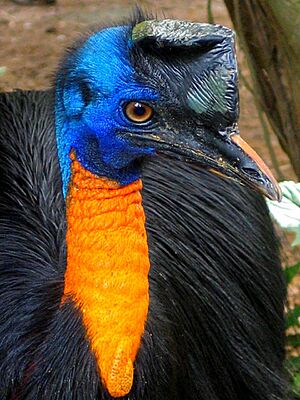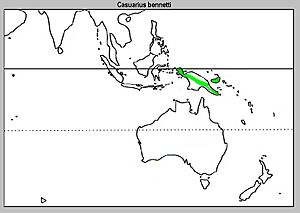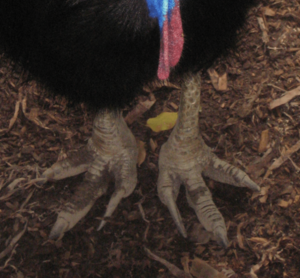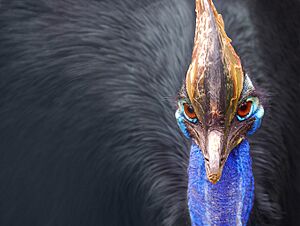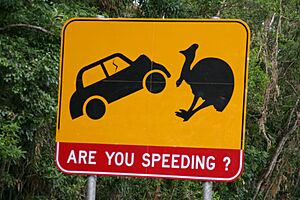Cassowary facts for kids
Quick facts for kids Cassowary |
|
|---|---|
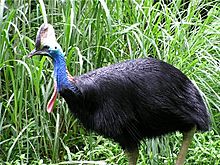 |
|
| Southern cassowary | |
| Scientific classification | |
| Kingdom: | |
| Phylum: | |
| Class: | |
| Order: |
Struthioniformes
|
| Family: |
Casuariidae
|
| Genus: |
Casuarius
Brisson, 1760
|
| Species | |
|
Casuarius casuarius |
|
Cassowaries (Casuarius) are large birds that cannot fly. They belong to a group of flightless birds called ratites. Other ratites include the ostrich, emu, and the small kiwi. The moa, which is now extinct, was also a ratite.
Cassowaries live in the tropicalrainforests of New Guinea and northeastern Australia. They are usually shy birds that stay deep in the forest. However, they can become aggressive and might attack people if they feel threatened. This makes them hard to study.
Contents
- Where Cassowaries Live
- What Cassowaries Look Like
- Types of Cassowaries
- Cassowary Reproduction
- The Casque: A Mysterious Helmet
- What Cassowaries Eat
- Threats to Cassowaries
- Are Cassowaries Endangered?
- Saving the Cassowary
- Cassowaries in Art and Culture
- Interesting Facts About Cassowaries
- Related Pages
- Images for kids
- See also
Where Cassowaries Live
Cassowaries naturally live in the wet rainforests of New Guinea. They also live on nearby smaller islands, East Nusa Tenggara, the Maluku Islands, and northeastern Australia.
What Cassowaries Look Like
The southern cassowary is the biggest forest bird in the world. It is also the second heaviest bird after the ostrich. It is the third tallest bird, after the ostrich and emu. Female cassowaries are larger and have brighter colors than males.
Adult southern cassowaries are usually between 1.5 meters (5 feet) and 1.8 meters (6 feet) tall. Some females can grow up to 2 meters (6.5 feet) and weigh about 70 kilograms (150 pounds). Their necks do not have feathers and are brightly colored. You can see shades of red, blue, purple, and yellow.
Special Features of Cassowaries
The southern cassowary has two loose flaps of skin called wattles hanging from its neck. The northern cassowary has one wattle. The dwarf cassowary does not have any wattles.
Cassowaries have three toes on each foot. Each toe has a very sharp claw. The middle toe has a claw that looks like a dagger, which can be 120 millimeters (5 inches) long. Because a cassowary can kick strongly, this claw is very dangerous. It can hurt or even kill enemies.
Scientists believe cassowaries can run up to 50 kilometers per hour (30 mph). They can also jump up to 1.5 meters (5 feet) high and are good swimmers. There have been reports of cassowaries attacking people and other animals. In one case in 1926, a cassowary caused a serious injury to a teenager in Australia.
Cassowaries have small wings. These wings do not have flight feathers and are not made for flying.
Types of Cassowaries
There are three living species of cassowary:
- Southern cassowary, Casuarius casuarius: This type lives in Australia and New Guinea.
- Northern cassowary, Casuarius unappendiculatus: This one lives in New Guinea and New Britain. It is also known as the Single-wattled cassowary or Gold-necked cassowary.
- Dwarf cassowary, Casuarius bennetti: This species lives in New Guinea. It weighs up to 25 kilograms (55 pounds) and can grow to 1 meter (3 feet) tall. It is also called Bennett's cassowary or Mountain cassowary.
Cassowary Reproduction
Female cassowaries lay between three and eight large eggs at a time. These eggs are pale green-blue. They are about 90 millimeters (3.5 inches) by 140 millimeters (5.5 inches) and weigh about 600 grams (1.3 pounds). Ostrich and emu eggs are even bigger.
The male cassowary sits on the eggs for two months until they hatch. After the chicks are born, he takes care of them for nine months. The chicks have brown stripes. A female cassowary may mate with two or three different males each year. One cassowary at the Healesville Sanctuary lived for 61 years.
The Casque: A Mysterious Helmet
All three types of cassowary have a hard, helmet-like growth on top of their head. This is called a casque. The casque is made of a material like a fingernail (keratin) over a firm, foam-like inside. This material can bend and squeeze but returns to its original shape.
The name cassowary comes from two Papuan words that mean "horned head." Scientists are not completely sure why cassowaries have this casque. Here are some ideas:
- It might be for mating, as the female's casque is larger.
- It could help the bird push through thick forest plants.
- It might be a weapon for fighting other cassowaries.
- It could be a tool for moving leaf litter when looking for food.
- It might protect the cassowary's skull if it bumps into trees.
Biologist Andrew Mack has studied cassowaries and has different ideas. He thinks the casques might help cassowaries hear or make sounds. He found that dwarf and southern cassowaries make a very low sound. It is the lowest known bird call, like a deep "boom," which humans can barely hear. The southern cassowary's sound was measured at 32 hertz, and the dwarf cassowary's was even lower at 23 hertz.
Since these birds live alone, this "booming sound" might be a way for them to communicate over long distances in the dense rainforest. Scientists even think that this way of talking might be how dinosaurs communicated with each other.
What Cassowaries Eat

Cassowaries mainly eat fruit. But they also eat other things like snails, fungi, ferns, and flowers. They are very important for the forest because they help spread plant and fruit seeds.
Each cassowary lives in an area of up to 700 hectares (1,700 acres). This means they carry seeds a long way. At least 70 rainforest trees need cassowaries to spread their seeds. The seeds from these trees are too big for other rainforest animals to carry. Seeds from 21 plants must be eaten and pass through a cassowary to grow. Some seeds are poisonous to all other animals, but only the cassowary can eat them safely. Scientists believe about 150 rainforest plants rely on the cassowary.
Threats to Cassowaries
In their main home of New Guinea, cassowaries do not have many natural enemies besides humans.
Young cassowary chicks can be hunted by large pythons, monitor lizards, New Guinea singing dogs, and Papuan eagles.
In Australia, cassowaries face dangers from vehicles. They also compete with wild boars for food. Wild boars are a big threat to cassowary eggs. Their chicks are also in danger from domesticated dogs. These threats cause the cassowary population in Australia to decline.
Are Cassowaries Endangered?
The southern cassowary is now listed as endangered in Australia. Scientists think there are only between 1,200 and 1,500 southern cassowaries left in Australia. Many of the forest areas where they live have been cleared for farms and other buildings. About 75% of the rainforest where cassowaries used to live in Australia has been cleared.
When Cyclone Larry hit the Mission Beach area in 2006, a lot of cassowary forest was destroyed. It is thought that 18% of the birds were killed by the storm. Animals like wild pigs, dogs, and cats are also a big threat to the birds. Cars are a major danger. Scientists say that 70% of known cassowary deaths at Mission Beach, Queensland, were birds killed trying to cross roads.
The northern cassowary in New Guinea is listed as vulnerable. This means they could easily become endangered if steps are not taken to protect them. Scientists do not know exactly how many northern cassowaries there are, but they estimate between 2,500 and 9,999 birds remain.
Saving the Cassowary
The CSIRO is studying cassowary droppings (feces) to use their DNA to count how many birds are left. In 2008, the Australian Government stopped rainforest land from being used to build houses at Mission Beach. They are trying to create "corridors," which are narrow forest areas, so the birds can move safely between rainforest patches. People are being asked to replant forest trees and plants on their land to help make these corridors. The government is also looking at buying land for more corridors.
Scientists are finding out when and where cassowaries cross roads. This will lead to strict speed limits for cars to protect cassowaries crossing certain roads. Plans are also being considered to build raised roads so the birds can pass underneath safely.
Many zoos, such as the Australian Reptile Park in Gosford, the Airlie Beach Wildlife Park, and the Denver Zoo, are working to breed cassowaries. Cassowaries in zoos have lived for up to 60 years. The first cassowary kept in a zoo was in Amsterdam in 1597. It was brought as a gift for the Holy Roman Emperor Rudolf II.
Cassowaries in Art and Culture
In 2007, Australian singer Christine Anu released an album for children called Chrissy's Island Family. One of the songs on it is called Cassowary, about a cassowary named Samu. There is also a children's picture book called Sisi and the Cassowary by Arone Raymond Meeks. It features drawings in a traditional Aboriginal style and tells a Dreamtime-like story.
The English natural history writer and artist, John Gould, included drawings of the cassowary in his seven-book series, The Birds of Australia. These books were printed in London between 1851 and 1869. The cassowary drawings were done by Henry Richter. Richter's watercolor painting of the cassowary is in a museum in Melbourne, Victoria.
Interesting Facts About Cassowaries
- Cassowaries are the only native Australasian animal known to have been partly tamed by people before Europeans arrived.
- A group of cassowaries is called a "shock."
- The southern cassowary is the third-tallest and second-heaviest living bird, only smaller than the ostrich and emu.
- Unlike most birds, cassowaries do not have a tongue.
- The cassowary has often been called "the world's most dangerous bird." If they feel threatened, cassowaries can cause serious injuries.
- Wild cassowaries usually live for about 18–20 years. Those in captivity can live up to 40 years.
- Cassowaries are solitary birds. They only come together during courtship, when laying eggs, and sometimes around large amounts of food.
- The poisonous cassowary plum fruit is named after the bird.
- There is evidence that cassowaries might have been tamed by humans thousands of years before chickens.
- Cassowaries can eat all types of human food, even processed ones, if they are interested. However, fruit is still their favorite.
- In zoos, cassowaries get most of their protein from dog or monkey food.
- Eating cassowary meat is said to be quite tough. Australian officers in New Guinea were once advised that it "should be cooked with a stone in the pot: when the stone is ready to eat, so is the cassowary."
Related Pages
- Elephant bird
- Terror birds
- Phorusrhacos
- Brontornis
- Dromornis
- Gastornis (Diatryma)
Images for kids
-
A road sign in Cairns, Queensland, Australia
See also
 In Spanish: Casuarios para niños
In Spanish: Casuarios para niños


